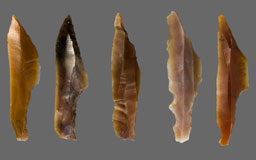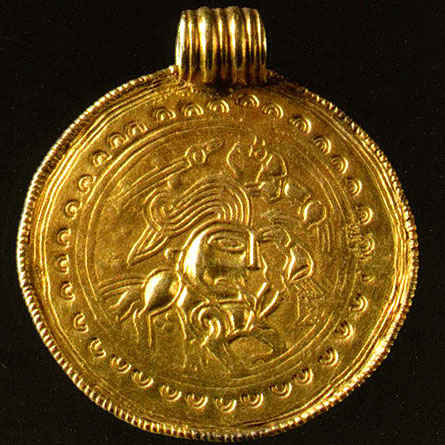Man and Artefact
The North Sea and Baltic region is frequently reflected in the archaeological finds as an autonomous and interconnected area of social interaction throughout the ages. From the Stone Age hunters and gatherers to the Germanic cultures of the early Middle Ages, the inhabitants created their own special artefacts, which can be classified in the functional, technological, typological, chronological and cultural categories that form the traditional foundation of all archaeological research.
Individual artefacts as well as whole categories of objects thus allow conclusions to be drawn about the people who made and used them. Interdisciplinary methods can be applied to reconstruct individual lives, complex social structures and value systems as aspects of human existence in its historical dimension.

Gleichzeitig sind Fragestellungen der kognitiven Archäologie relevant, indem die Motive, Ziele und geistigen Hintergründe sowohl einzelner Artefakthersteller als auch ganzer Gesellschaften bearbeitet und die Entwicklung allgemeiner menschlicher Vorstellungswelten und Mentalitäten erforscht werden. Die Form bzw. das Aussehen eines Artefaktes ist Produkt bewusster wie auch unbewusster Prozesse. Seine Anfertigung und Gestaltung sind abhängig von vielen Parametern, etwa den intellektuellen, physiologischen und technologischen Kapazitäten der Hersteller, wie auch von deren Ressourcen. Doch nur zum Teil bestimmten die Funktionalität oder der persönliche Geschmack des Herstellers die konkrete Formgebung eines Objektes. Vielmehr waren Traditionen und Konventionen, kulturelle und religiöse Gründe für die Gestaltung von Artefakten und insbesondere für jegliche Art von Verzierung auf ihnen ausschlaggebend. Denn Handwerk und Technologie waren immer vorwiegend kulturell bedingt. Daher eignet sich die Erforschung technologischer Standards auch als Schlüssel zum Verständnis einer Gesellschaft allgemein. Es können wertvolle Hinweise auf deren Fähigkeiten, Möglichkeiten, die interne Organisation wie auch auf interkulturelle Beziehungen gewonnen werden, deren Einflüsse beispielsweise als technologische oder ikonographische Innovationen im Fundmaterial sichtbar sind.

Conversely, material culture – be it in the form of standardised groups of artefacts, characteristic shapes or typical decorations – has a formative effect on people. Growing up and living in a particular artefact milieu influences those who belong within its sphere; their interaction with these objects creates both an individual and a socio-cultural identity. This is especially true of figurative or ornamental decoration such as the unique and characteristic animal style found in the North and Baltic Sea regions during the first millennium AD. But why did people create, at specific times, only very specific types of object or, as in this case, very specific motifs and styles – and when, how and why were these norms then further developed or modified? These are the questions that are investigated here. Thus, in the Strategic Research Area “Man and Artefact”, the ZBSA undertakes a diachronic and interdisciplinary examination of the cultural aspects of material communication and the relationship between man and material object.
The following Research Priorities are included in this Strategic Research Area:
Visual History
Sacrifice of military equipment
Technology – Tradition and Innovation
Laufende Forschungsprojekte des Themenbereichs:
- Archäologische Bildwissenschaft
- Amber finds in Northern Europe from the Roman Iron Age till the Vendel Period
- Bildersprache
- Crafts apprenticeship and transmission of knowledge in Early Bronze Age flint working
- Defining the Ahrensburgian. Contributions from a technological study of reindeer antler artefacts
- Digitale Neu-Edition der gotländischen Bildsteine
- Forschungen zur Geschichte der Jagd
- Goldblechfiguren. Ikonographie, Datierung und Funktion der skandinavischen guldgubbar
- Goldbrakteaten der Völkerwanderungszeit
- Lithics Analysis Laboratory
- Medaillon-Imitationen – Vorbilder im Römischen Reich, Fundumstände und Funktion in Nordeuropa
- Nydam mose – weapons
- Origins and Influences on Early Gotlandic Picture Stones
- Raptor on the fist – falconry, its imagery and similar motifs throughout the millennia on a global scale
- Long Blades as markers of long-distance connections?
- Technological transformations in the Lateglacial– Hunter-gatherers in a changing environment